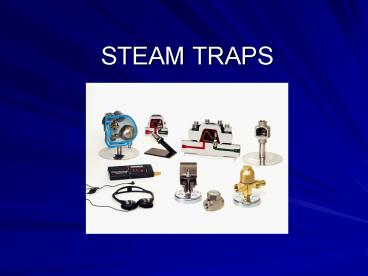STEAM TRAPS - PowerPoint PPT Presentation
1 / 19
Title:
STEAM TRAPS
Description:
STEAM TRAPS Trap Basics Whenever possible, steam traps should be located ~2 foot from, and below the discharge of the equipment. Strainers, whether built in or ... – PowerPoint PPT presentation
Number of Views:1066
Avg rating:3.0/5.0
Title: STEAM TRAPS
1
STEAM TRAPS
2
Trap Basics
- Whenever possible, steam traps should be located
2 foot from, and below the discharge of the
equipment. - Strainers, whether built in or separate, are
recommended with all steam traps. - Install ball (or gate) valves before and after
the steam trap to ease maintenance by isolating
the trap from the rest of the system.
3
Trap Basics
- Unions should be installed between the isolating
valves and steam trap so that the trap can be
easily removed and replaced as required. - Blowdown valves are recommended at strainer
outlet - A test valve or a sight flow indicator are
recommended to determine if system is operating
and functioning properly
4
Pipe Scale Dirt
- When new piping is installed, chunks of solder,
fragments of metal parts, packing, and even nuts
and bolts are often left inside. - In older piping systems, there is a build-up of
scale and dirt that can break free and travel
through the steam system. - Pipe scale and dirt can permanently damage steam
equipment, especially steam traps. To overcome
this - Install a strainer prior to every steam trap
- Utilize a dirt pocket in front of the trap to
accumulate dirt and scale.
5
Steam Main Drip Leg
- Steam main drip pockets are recommended at every
horizontal and vertical change of direction in
piping, and in front of all equipment such as
control valves, PRVs, or shut off valves because
these are natural collection points. - The distance between drain pockets should
decrease as the steam main size increases because
of the additional amount of energy (water hammer)
larger mains have that could cause damage. - A rule of thumb for spacing drip pockets is the
higher the pressure or larger the main, the
closer the spacing.
6
Steam Main Drip Leg
- For steam main up to 6, a full size drip leg
should be installed. Over 6, a collecting leg of
½ of the pipe size can be utilized, as long as it
is not under 6 - The take off of the steam trap should be at a
point 3 above the lower level of the drip leg,
draining by gravity
7
Back Pressure Effect
- The general rule of thumb for calculating the
back pressure of condensate lift installations is
1psig back pressure for each 2 foot of vertical
lift. For low pressures, use 1psig per foot for
lift.
8
Bypass Loops
- Bypass loops are needed when the trap capacity
can not meet the start-up requirements. - CAUTION Bypass could be inadvertently left open,
allowing large amounts of live steam to be lost
when hot running load is achieved. - Most steam trap manufactures discourage the use
of bypass loops. By selecting a trap with high
start-up capacity, the bypass is not needed.
9
Traps in Parallel
- Parallel traps are used in critical process
applications where the unit can not be shut down
for servicing. One trap can be on while the other
is serviced. - Good alternate to the bypass loop installation
because it eliminates the possibility of blowing
live steam through an inadvertently open bypass
valve. - Negative More Expensive
10
Space Heating Equipment
- In order to facilitate good drainage from the
equipment, a vertical leg (at least 12 long)
should be installed on the bottom of the
equipment. - If the unit heater has a modulating valve on the
inlet, consideration must be given to the ?P
across the trap so that there is always enough
steam pressure to remove condensate.
11
Space Heating Equipment
- The installation of a vacuum breaker is vital
whenever steam is controlled to the unit heater
with a modulating control valve. - An air vent installed at the opposite corner from
the inlet steam supply helps remove air from the
remote areas of the equipment.
12
Shell Tube Heat Exchangers
- Optional vacuum breaker installed to allow free
drainage of condensate when system is off. - The air vent is used to remove the air that may
be introduced through the opening of the vacuum
breaker or from the steam supply.
13
Delta Element
14
Delta Cycle-Start up
- At cold start up, stem is full open to allow high
flow capacity - Only one moving part for simple design
15
Delta Cycle-Closing
- Stem starts to close as condensate temperature
increases - Flow will modulate as condensate is formed
16
Delta Cycle-throttle
- Stem throttles shut when condensate reaches
temperature of saturated steam - Expansion chamber allows extra capacity before
shut off
17
Delta Cycle-Shut off
- Stem is tightly shut when steam is present
- Single, open blade design allows faster response
to temperature changes
18
The Delta Cycle
19
Blowing Steam vs. Flash Steam































